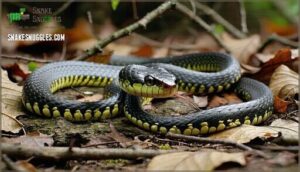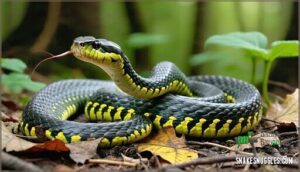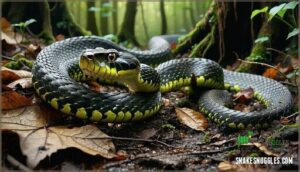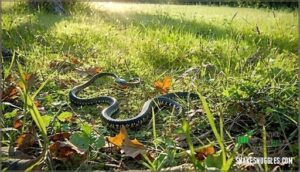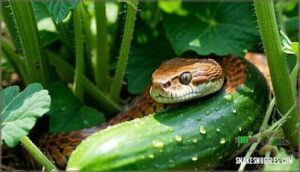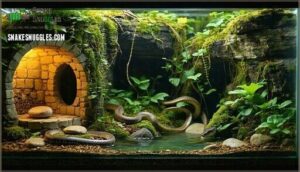This site is supported by our readers. We may earn a commission, at no cost to you, if you purchase through links.
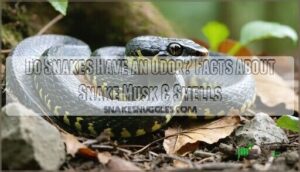 You’ve probably walked past countless snakes without knowing it—not because of their camouflage, but because most species produce no detectable odor during normal activity. The exception comes when these reptiles feel threatened, triggering specialized glands near their tail to release a pungent defensive secretion called musk.
You’ve probably walked past countless snakes without knowing it—not because of their camouflage, but because most species produce no detectable odor during normal activity. The exception comes when these reptiles feel threatened, triggering specialized glands near their tail to release a pungent defensive secretion called musk.
This chemical deterrent, composed of volatile compounds like trimethylamine and fatty acids, transforms a silent predator into something no animal wants to eat.
Whether you’re a curious hiker, prospective snake owner, or someone who caught an unusual whiff outdoors, understanding when and why snakes produce odors helps you interact safely with these misunderstood creatures.
Table Of Contents
- Key Takeaways
- Do Snakes Secrete Musk?
- How Often Do Snakes Secrete Musk?
- Why Do Snakes Secrete Musk?
- What Does Snake Musk Smell Like?
- Why Does Snake Musk Smell So Bad?
- Surprising Smells Produced by Venomous Snakes in The US
- Do Snakes Smell Like Cucumber?
- How to Get Rid of Snake Musk
- How to Prevent a Snake From Spraying Musk
- The Usual Suspect
- Frequently Asked Questions (FAQs)
- What Other Defensive Tactics Do Snakes Use?
- Are Baby Copperhead Bites More Dangerous Than Adult Bites?
- What Does a Copperhead Look Like?
- Are All Venomous Snakes Found in the US?
- Are There Any Snake-Repelling Plants That Can Be Used?
- Can snakes detect human scent or fear?
- Do all snake species produce the same odor?
- How does a snakes diet affect its smell?
- Can you identify snake species by their scent?
- Do pet snakes smell different than wild snakes?
- Conclusion
Key Takeaways
- Most snakes produce no smell during normal activity, but release a pungent defensive musk from cloacal glands near their tail when threatened—a chemical cocktail of compounds like trimethylamine and fatty acids that varies widely by species in intensity and scent profile.
- The cucumber smell myth about copperheads isn’t reliable for snake detection since only some people can perceive this odor, it’s only released when the snake is directly disturbed, and scent perception varies by as much as 30% between individuals due to genetic differences.
- Snake musk functions as a last-resort defense mechanism rather than a constant deterrent, meaning snakes conserve their limited musk supply for genuine threats like being held or cornered, with captive snakes musking far less frequently than wild ones.
- You can prevent musk release and eliminate existing odor through calm handling techniques that minimize stress, immediate treatment with metal soap or white vinegar to break down sulfur compounds, and maintaining proper enclosure conditions for pet snakes.
Do Snakes Secrete Musk?
Ever wonder what triggers a snake to emit its notoriously stinky defense mechanism? When a snake feels threatened or stressed, specialized cloacal glands near its tail vent produce musk—a chemical cocktail of aldehydes and fatty acids designed to repel predators.
This musk secretion process varies greatly among species; cottonmouths release heavy, skunk-like odors, while copperheads produce milder, cucumber-scented musk. The musk gland location and composition make snake odor intensity differ widely, though venomous pit vipers most commonly employ this defensive tactic.
Understanding these species musk variations helps you recognize when you’re dealing with a stressed snake and adjust your approach accordingly.
How Often Do Snakes Secrete Musk?
You might assume snakes spray musk constantly like a skunk on high alert, but the reality is far more strategic. Snakes only release musk when they genuinely feel threatened—think of it as their last-resort defense mechanism rather than a daily routine. Musk secretion triggers include being held, sudden movements, or predator encounters, and the cloacal glands don’t produce unlimited supplies. Species musk frequency varies; garter snakes might musk more readily when startled, while ball pythons rarely deploy this tactic. Stress-induced musk usually occurs during capture or when escape routes are blocked, and seasonal musk variation can affect gland capacity during breeding periods.
Understanding when snake musk appears helps you stay safe:
- Snakes conserve their musk glands for genuine threats, not casual encounters
- Repeated being held increases the likelihood of triggering snake odor release
- Wild snakes musk more frequently than calm, well-acclimated captive specimens
- The pungent snake defense mechanism can linger on skin and clothing for hours
- Respecting a snake’s space drastically reduces your chances of experiencing this unforgettable smell
Why Do Snakes Secrete Musk?
Snakes deploy their musky arsenal for one primary reason: survival in a world where being small and vulnerable means you need every trick in the book to stay alive. This defense mechanism transforms them from easy prey into something far less appetizing—predators quickly learn that a snake covered in foul-smelling musk isn’t worth the trouble.
The musk glands, located near the cloaca at the tail’s base, produce a chemical cocktail designed to repel attackers. Species variation affects musk composition; garter snakes release a cloying secretion, while king rat snakes produce notoriously potent odors.
Beyond defense, some snakes use musk as mating signals to attract partners during breeding season.
What Does Snake Musk Smell Like?
So what does snake musk actually smell like when you encounter it? The answer depends on species and individual perception. Musk odor compounds include trimethylamine, 3-methylbutanoic acid, and other volatile fatty acids that create distinct sensory profiles.
Garter snake musk carries a leathery, fishy putridity—think dead fish mixed with wet rawhide. Water snakes produce something closer to rotten eggs, while Burmese pythons can emit an odor so foul it triggers gagging. Species musk variation means copperheads smell cucumber-like to some people, rattlesnakes emit heavy musky scents, and cottonmouths release skunk-like spray.
Musk smell intensity varies too—female garter snakes often produce more malodorous secretions than males, and factors affecting odor include diet and stress level during secretion. If you detect it, it’s important to maintain safety from snakes.
Why Does Snake Musk Smell So Bad?
The foul stench hits you like a wall because evolution turned snake musk into a chemical weapon—one specifically engineered to trigger revulsion in predators. The musk chemical composition includes volatile compounds like trimethylamine and sulfur-containing molecules that your brain interprets as "danger" or "decay." These defensive secretions come from specialized snake musk glands near the cloaca, and their evolutionary odor purpose is simple: make the snake taste and smell so repulsive that predators lose their appetite instantly.
Evolution weaponized snake musk with volatile compounds like trimethylamine and sulfur molecules that hijack your brain’s danger receptors, making predators instantly lose their appetite
Species odor intensity varies considerably—some snakes produce mild animal scent while others release glandular secretion processes that’ll clear a room. Diets impact the potency too; snakes eating fish or amphibians often produce stronger snake odor than those consuming rodents.
When you encounter snake musk, you’ll notice:
- A sharp, acrid smell that clings to clothing and skin
- Skunky or sulfurous notes mixed with rotting organic matter
- An oily residue that’s difficult to wash away completely
Surprising Smells Produced by Venomous Snakes in The US
When you’re out in snake country, it’s worth knowing that some of our venomous species produce surprisingly distinct odors under certain conditions. These smells can range from oddly pleasant to downright pungent, depending on the snake and the situation.
Let’s look at what three common venomous snakes in the US might smell like when you encounter them.
Copperheads
Copperheads rank as the most common venomous snake across the Southeast US, Texas, and heartland regions, making encounters more likely than you’d think. You’ll recognize them by their distinctive copper-colored heads, hourglass-shaped bands, and semi-aquatic habits near streams and wetlands.
When threatened or touched, copperheads release a defensive musk from cloacal glands near their tail—a smell often described as fresh cucumber odor, though some perceive it as musky or earthy. This copperhead musk functions as a chemical deterrent, signaling to predators that the snake won’t make a palatable meal.
Don’t let the mild cucumber scent fool you into complacency; bite danger remains serious with neurotoxic venom requiring immediate medical attention. Most bites happen when people accidentally step on or try to pick up these well-camouflaged snakes, so watch your footing in their habitat range. Recognizing this smell can be a sign of a snake pest problem.
Rattlesnakes
Like their copperhead cousins, rattlesnakes produce defensive musk from cloacal glands when they feel threatened—though you can’t always count on smelling it before an encounter. This snake musk generally carries a cucumber-like scent, though some people detect musky or pungent notes depending on the species and individual olfactory perception.
Scent variation occurs across rattlesnake habitats, from deserts to forests, where different environmental conditions may influence how you perceive these habitat odors. The defensive behavior includes the famous tail rattle, but musk release only happens when the snake feels genuinely cornered or picked up.
These venomous snakes don’t spray musk constantly—it’s one of several animal defense mechanisms they reserve for serious threats, making the odor an unreliable warning sign in most outdoor situations.
Cottonmouths/Water Moccasins
When you’re near swamps or slow-moving streams, cottonmouths—also called water moccasins—give off one of the most pungent examples of venomous musk you’ll encounter. Unlike the cucumber-like scent of copperheads, cottonmouth musk hits with a foul, skunk-like odor that some describe as rotting fish, making this defensive behavior hard to ignore.
You’ll find these semi-aquatic snakes in the southeastern United States, where their diet of amphibians, fish, and small mammals may influence the particularly strong snake odor they produce. When threatened, they’ll gape their white mouths—the namesake feature—and release musk as a warning before resorting to biting.
Their habitat odors near waterways can mask snake smell until you’re close, so watch for their distinctive catlike pupils and stocky bodies. If you detect that unmistakable skunk-like scent during a hike, it’s your cue to back away carefully and give these venomous snakes their space.
Do Snakes Smell Like Cucumber?
You’ve probably heard the old story that snakes smell like cucumbers, but here’s the reality: it’s more myth than fact. This belief stems from folklore about copperheads, whose defensive musk—released only when threatened—sometimes registers as cucumber-like to certain people.
However, scent perception variability means not everyone detects this odor, and many encounter copperheads without noticing any smell at all. Snake musk contains volatile organic compounds like acids and amines, but no consistent chemical basis links copperhead musk to cucumber odor.
The truth is, musk release incidence is rare unless you directly disturb or touch the snake, making the cucumber myth unreliable for identifying snake presence or guaranteeing your safety.
How to Get Rid of Snake Musk
If you’ve ever been on the receiving end of snake musk, you know it’s not something that washes off easily—but with the right approach, you can eliminate even the most stubborn odor. Multiple washings with warm water and soap form the foundation of musk removal methods, though you’ll likely need specialized cleaning solutions for complete scent neutralization. Metal soap—designed to break down sulfur compounds—works exceptionally well, as does white vinegar, which neutralizes the acids and amines in snake musk. For persistent snake odor on clothing or fabrics, enzymatic cleaners target the organic compounds responsible for the smell.
Effective odor prevention strategies include:
- Treating pet snakes gently during routine spot cleaning and snake enclosure maintenance to minimize stress-induced musk release
- Applying cleaning solutions immediately after musk contact, before the compounds set into fabric or skin
- Consulting professional services for severe contamination or when dealing with repeated musk incidents in your snake enclosure
Remember, patience matters—stubborn musk requires repeated applications until the odor completely disappears.
How to Prevent a Snake From Spraying Musk
The best defense against snake musk is prevention—understanding what triggers this pungent spray helps you avoid it altogether. Snakes release musk primarily when stressed or threatened, so minimizing these situations protects both you and your snake.
Proper holding techniques—supporting the body fully and moving slowly—signal safety to your snake. Thoughtful enclosure design with adequate hides reduces stress daily, while maintaining consistent spot cleaning schedules prevents anxiety-inducing disruptions. During breeding season, when snakes become more defensive, give them extra space.
Five strategies to prevent musk release:
- Hold your snake only when necessary, using calm, confident movements
- Maintain best temperatures and humidity in the snake enclosure to reduce environmental stress
- Avoid holding during shedding periods or shortly after feeding
- Recognize snake behavior signals—hissing or coiling means back off
- Assure diet influence doesn’t create digestive stress through appropriate prey sizing
The Usual Suspect
Regarding venomous snakes in the southeastern United States, copperheads take the lead as the most common culprit behind snakebites. These widespread pit vipers don’t always announce their presence with loud warnings like rattlesnakes do, which means you’re more likely to encounter one without realizing it until it’s too late.
Let’s clear up some common misconceptions and facts about copperheads that could help keep you safe.
Do You Smell Cucumber?
You might’ve heard the old warning that a cucumber smell means danger, but does that folklore hold up when you actually encounter a snake in the wild? While some rattlesnakes do emit cucumber-like compounds when threatened, not all snakes produce this scent, and your nose might not pick it up the same way someone else’s does.
| Factor | Reality |
|---|---|
| Rattlesnake odor consistency | Only certain species produce cucumber compounds |
| Scent perception differences | Smell genetics cause 30% variation between people |
| Musk characteristics | Species variation ranges from sweet to skunky |
| Snake smell reliability | Not a dependable warning system in the wild |
Are Baby Bites Worse?
Contrary to popular belief, baby venomous snakes don’t pack a more dangerous punch than their parents—but that doesn’t mean you should let your guard down. Young copperheads and rattlesnakes inject venom with less control than adults, but their toxicology isn’t more potent. Bite severity depends on injection control and venom delivery, not age.
All bites require immediate medical treatment—myth debunking aside, baby snakes still secrete musk when threatened and deliver dangerous venom.
Dry Bites
Even non-venomous snake encounters can result in what’s called a dry bite—when fangs pierce skin but no venom is injected—though you shouldn’t bet your safety on it.
Venomous snakes like copperheads and rattlesnakes can deliver dry bites about 20-30% of the time, but bite severity isn’t predictable in the field. Snake defense mechanisms vary, and venom absence doesn’t guarantee safety.
Always treat snake bites as medical emergencies requiring immediate first aid and professional care—long-term effects from assuming a bite is "dry" can be life-threatening.
The Nest Myth
Most people believe copperheads build traditional nests like birds, but snakes don’t construct nests at all—they’re ovoviviparous, meaning females give birth to live young that scatter almost immediately after arrival.
This myth persists because frightened homeowners sometimes discover multiple baby copperheads in one area, mistaking these temporary gatherings for intentional nesting behavior. In reality, you’re encountering newborns that haven’t dispersed yet, not evidence of parental care or communal nesting—though their combined musk and waste can create a repulsive odor that signals their presence.
Watch Where You Step
Copperheads aren’t aggressive by nature, but they’re masters of camouflage—meaning your boot could land inches from one before you even notice it’s there.
That’s why protective footwear and habitat awareness matter during trail safety outings—closed-toe boots and long pants create barriers against accidental snake bites.
If you’re bitten, don’t panic: the cloacal glands that produce snake musk won’t help you identify species in an emergency, so focus on getting immediate first aid and medical attention instead of analyzing snake odor.
Frequently Asked Questions (FAQs)
What Other Defensive Tactics Do Snakes Use?
When threatened, snakes deploy various defensive tactics beyond musk secretion. Hissing loudly and expanding their necks intimidate predators through visual and auditory displays. Some species engage in defensive posturing, coiling tightly or flattening their bodies. Venomous snakes may spray venom or deliver dry bites without injecting toxin.
Playing dead is another predator avoidance strategy, while certain species use tail luring to distract attackers. Autotomy defense, though rare in snakes, involves voluntary tail loss.
These reptile behavior and biology adaptations, combined with snake odor and defense mechanisms, represent extensive animal defense mechanisms guaranteeing survival.
Are Baby Copperhead Bites More Dangerous Than Adult Bites?
There’s a common myth that baby copperhead bites are more dangerous than adult bites, but that’s not actually true. Young copperheads can’t control their venom injection as precisely, while adults deliver larger venom doses overall.
This makes adult bites more severe and requires higher antivenom dosages for treatment.
What Does a Copperhead Look Like?
These semi-aquatic pit vipers display distinctive triangular heads with vertical, cat-like pupils and bodies ranging from pinkish to tan, adorned with characteristic hourglass-shaped crossbands.
Juvenile copperheads sport sulfur-yellow tail tips, which fade as they mature, and their camouflage patterns help them blend seamlessly into leaf litter across Southeastern states, Texas, and heartland habitats.
Are All Venomous Snakes Found in the US?
You’ll encounter venomous snakes across varied landscapes, from the Southeast’s copperheads to the desert-dwelling rattlesnakes and semi-aquatic cottonmouths in Southern waterways.
Each species has carved out its preferred habitat, making regional awareness your best defense against unexpected encounters.
Are There Any Snake-Repelling Plants That Can Be Used?
While some plants like marigolds, daffodils, and ironwood trees are often cited as snake repellents, scientific evidence supporting their effectiveness remains limited.
You’re better off using proven habitat modification strategies—removing debris, sealing entry points, and maintaining clear yards—to reduce snake encounters naturally.
Can snakes detect human scent or fear?
Like a living antenna tuned to chemical signals, you leave an invisible trail wherever you go. Snakes can detect your scent through their complex olfactory system, using their forked tongues and Jacobson’s organ to process the chemical particles you shed.
However, they can’t smell fear itself—there’s no evidence snakes perceive stress-related pheromones from humans.
Do all snake species produce the same odor?
Odor uniqueness is real—snake species don’t all smell the same. Diet influence and habitat impact play roles, while genetics matter too.
Age variation, musk glands, Snake Musk, and pheromone communication all shape that signature snake odor.
How does a snakes diet affect its smell?
You’re in for a feeding frenzy of facts! Your snake’s diet directly influences its odor through prey scent retention and digestion byproducts.
Snake waste carries remnants of consumed prey, while gut microbiome processes create distinct smells that vary by diet composition.
Can you identify snake species by their scent?
While you can’t reliably identify snake species by scent alone, some species do produce distinctive musk odors. Species-specific scents vary—garter snakes emit a cloying smell, while rattlesnakes can smell like cucumbers—but olfactory confusion and individual variation make scent identification unreliable for species determination.
Do pet snakes smell different than wild snakes?
In short, pet snakes smell cleaner than wild ones because of controlled enclosure conditions, regular snake care, and lower stress levels.
Snake musk from wild snakes often reflects diverse dietary influence, natural animal scent marking behaviors, and varied snake habitats, while snake odor in captivity depends heavily on care effects and genetic factors.
Conclusion
Most snakes don’t have an odor—until they do. Whether you’re hiking backcountry trails, interacting with a captive snake, or teaching children to respect wildlife, knowing that these reptiles save their stink for genuine threats changes how you approach them.
Interact calmly, move deliberately, and give wild snakes space. Do that, and you’ll likely never experience the sulfurous reality of defensive musk. Respect their boundaries, and they’ll keep their chemical weapons holstered.

